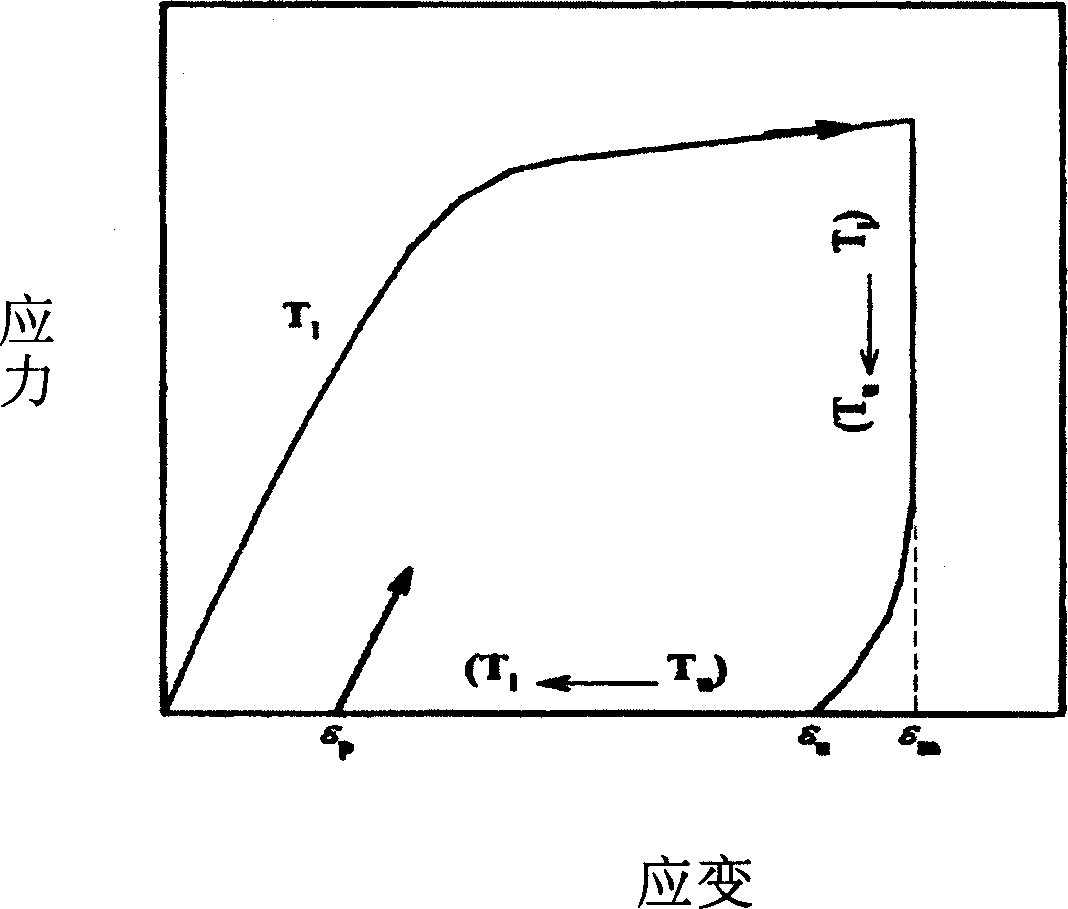Shape memory fiber and its prepn process
A memory fiber and memory technology, which is applied in the fields of fiber chemical characteristics, textiles and papermaking, single-component synthetic polymer rayon, etc., can solve problems such as poor interface bonding, inaccurate shape memory temperature, and weak deformation recovery. Achieve significant social and economic benefits, good shape memory characteristics, and increase the effect of varieties
- Summary
- Abstract
- Description
- Claims
- Application Information
AI Technical Summary
Problems solved by technology
Method used
Image
Examples
Embodiment 1
[0063] Add 0.02 kg of dibutyltin laurate, 60 kg of polycaprolactone diol (number-average molecular weight 3000), 6.96 kg of 2,4-toluene diisocyanate, and 400 kg of dimethylformamide into 1000L of reversible phase components with In a reactor with a stirrer, a thermometer and a reflux condenser, react at a temperature of 70-80° C. for 2 hours. Then lower the temperature to 50-55°C, add 5.4 kg of stationary phase components 1,4-butanediol, 0.1 kg of trimethylolpropane, 20 kg of 4,4'-diphenylmethane diisocyanate and dimethylol propane 1.34 kg, temperature control 55-60 ℃, after 3-4 hours of reaction, add 131 kg of acetone to adjust the viscosity, and obtain colorless to light yellow, viscous polyurethane.
[0064] Through theoretical calculation, the -NCO:-OH=1:1.27 of the polyurethane obtained in this example; the mass percentage of the stationary phase is 37.1%, and the mass percentage of the reversible phase is 62.9%; its mass percentage is 15%; the crystallization melting po...
Embodiment 2
[0067]0.01 gram of stannous octoate, 24 grams of polycaprolactone diol (number average relative molecular mass 4000), 6 grams of polyethylene adipate glycol (number average relative molecular mass 1000), 6 grams of hexamethylene diol Add 5.0 g of isocyanate and 100 g of dimethylacetamide into a 250 mL reaction flask equipped with a stirrer, a thermometer and a reflux condenser, and react at a temperature of 65-70° C. for 2 hours. Then cool down to 55-60°C, add 1.0 grams of 1,4-butanediol, 1.0 grams of diethylene glycol, 2.0 grams of castor oil, 11.96 grams of 4,4'-diphenylmethane diisocyanate and dimethylol 1.48 g of butyl carboxylate, temperature controlled at 60-65° C., after 3 hours of reaction, 57 g of methyl ethyl ketone was added to adjust the viscosity to obtain light yellow, viscous polyurethane.
[0068] Through theoretical calculation, the -NCO:-OH=1.5:1.0 of the polyurethane obtained in this example; the mass percentage of the stationary phase is 50.0%, and the mass...
Embodiment 3
[0072] 0.02 kilogram of trimethylene diamine, polybutylene adipate diol (number-average molecular mass 4000) 85 kilograms, polyethylene glycol (number-average molecular mass 600) 15 kilograms, isophorone two Add 10.45 kg of isocyanate and 375 kg of dimethyl sulfoxide into a 1000L reactor equipped with a stirrer, thermometer and reflux condenser, and react at a temperature of 78-80°C for 2-3 hours. Then lower the temperature to 55-60°C, add 2.36 grams of 1,6-hexanediol, 1.125 kg of glycerol, 10.21 kg of 4,4'-diphenylmethane diisocyanate and 1.5 kg of tartaric acid, and control the temperature at 60-65°C. After 3 hours, the temperature was lowered to 30-40°C, and a colorless, viscous polyurethane was obtained.
[0073] Through theoretical calculation, the -NCO:-OH=1.0:1.0 of the polyurethane obtained in this example; the mass percentage of the stationary phase is 20.0%, and the mass percentage of the reversible phase is 80.0%; its mass percentage is 25%; the crystallization mel...
PUM
| Property | Measurement | Unit |
|---|---|---|
| Glass transition temperature | aaaaa | aaaaa |
| Fineness | aaaaa | aaaaa |
| Strength | aaaaa | aaaaa |
Abstract
Description
Claims
Application Information
 Login to View More
Login to View More - R&D
- Intellectual Property
- Life Sciences
- Materials
- Tech Scout
- Unparalleled Data Quality
- Higher Quality Content
- 60% Fewer Hallucinations
Browse by: Latest US Patents, China's latest patents, Technical Efficacy Thesaurus, Application Domain, Technology Topic, Popular Technical Reports.
© 2025 PatSnap. All rights reserved.Legal|Privacy policy|Modern Slavery Act Transparency Statement|Sitemap|About US| Contact US: help@patsnap.com

